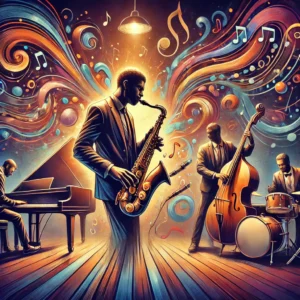Have you ever wondered what it takes to be considered a genius in the world of modern jazz? When talking about innovation and creativity, Jason Moran is a name that stands out as a beacon of brilliance in the genre. His contributions to contemporary jazz have not only redefined the boundaries of music but have also illuminated the paths for countless aspiring musicians. Let’s take a journey into the versatile world of Jason Moran and uncover how he has shaped modern jazz with his genius.
The Emergence of Jason Moran in Jazz
Early Influences and Background
Jason Moran’s introduction to music was not just a career choice; it was a seamless integration into his life’s fabric. Born in Houston, Texas, his journey began with classical piano lessons at the age of six. His taste for jazz was sparked in his teenage years when he encountered the revolutionary sounds of Thelonious Monk. This moment would pivotally influence not just his playing style, but also his approach to music altogether. It was Monk’s 1959 album “Thelonious Monk with John Coltrane” that Jason credits with changing his life.

Education and Mentorship
Attending Houston’s High School for the Performing and Visual Arts and later studying at Manhattan School of Music, Moran received formal training that honed his skills immensely. Here, he met the likes of Jaki Byard—a mentor whose guidance would profoundly impact Moran’s artistic development. But beyond technique, it was the ethos of innovation and expressiveness that Moran absorbed from Byard, enabling him to merge traditional jazz with contemporary ideas.
The Genius Mindset: Moran’s Unique Vision
Exploring New Horizons in Jazz
Unlike many traditionalists, Moran possesses an extraordinarily eclectic style, marrying the timeless with the avant-garde. He is renowned for integrating visual art, literature, and theatrical elements into his music, effectively broadening jazz’s canvas. Whether through collaborations with visual artists like Adrian Piper or integrating the spoken word into his projects, Moran’s vision consistently seeks to redefine what jazz performance can entail.
Albums and Notable Works
Jason Moran’s discography is a testament to his innovative character. His debut album, “Soundtrack to Human Motion” (released under Blue Note Records), already showcased his artistic range by incorporating diverse musical elements that defied singular categorization. From there, projects like “Black Stars,” featuring saxophonist Sam Rivers, solidified him as a visionary. Each album serves not only as a musical contribution but as an exploration of culture, history, and identity.
Bridging the Worlds: Moran’s Contributions Beyond Music
Educational Impact
Moran has consistently shared his wealth of knowledge and passion for music with others. Appointed as the Artistic Director for Jazz at the Kennedy Center in 2011, he has spearheaded initiatives aimed at cultivating a new generation of jazz musicians. Through workshops and performances held across the nation, Moran’s influence extends far beyond his recordings; he is actively shaping the future of jazz education.
Cultural and Social Commentary
Jason Moran’s work is infused with a rich tapestry of cultural and social motifs. His project “In My Mind: Monk at Town Hall, 1959” does more than reinterpret Monk’s music; it contextualizes it within the civil rights era, offering a complex sonic narrative that reflects the turbulences and triumphs of the time. Such works function not only as musical endeavors but as cultural commentary, adding significant depth to his artistic profile.
Navigating the Future: Moran’s Legacy in Modern Jazz
Continuing Innovations
If there’s one thing constant about Jason Moran, it’s his propensity for evolution. His recent projects venture into digital art and experimental jazz, maintaining a spirit of novelty that keeps audiences engaged and critics in awe. Noteworthy is his project “The Harlem Hellfighters: James Reese Europe and the Absence of Ruin,” which used multimedia to honor the legacy of a WWI African American regiment bandleader, proving Moran’s continuous drive to connect past and present narratives through music.
Inspiring New Generations
The ripple effect of Moran’s work can be seen in the burgeoning talents he supports and inspires. By instilling a sense of curiosity and artistic bravery, Moran encourages young musicians to explore boundaries rather than adhere to them strictly. This encouragement is crucial in maintaining jazz’s relevance and dynamism as a genre that is both reflective and anticipative of change.
Why Jason Moran Matters
Shaping the Identity of Modern Jazz
It’s essential to recognize that Jason Moran’s impact goes beyond the notes and melodies he creates. He is instrumental in reinforcing jazz as a living art form—one that evolves by embracing its historical roots while confidently stepping into new territories. In a world that oftentimes leans heavily on genres and labels, Moran shows that jazz can be both a bridge and a vessel for profound artistic expression.
The Human Element
At its core, Moran’s work is deeply human. It’s not just about technical mastery, but about conveying emotions, narratives, and truths that transcend the instrument. Whether in his live performances or his recorded works, Jason Moran presents an invitation to experience music not just as an artistic form but as a medium of connection and understanding, signifying his true genius in modern jazz.
Conclusion
The genius of Jason Moran in modern jazz is irrefutable. His innovative approaches, visionary compositions, and commitment to education and cultural discourse have set him apart as a luminary figure in the world of music. By continuously challenging conventions and inspiring new generations, Jason Moran not only exemplifies the spirit of jazz but becomes a part of its ongoing legacy. Whether you’re a lifelong jazz aficionado or a curious newcomer, the exploration of Moran’s work offers a rewarding journey through the ever-expanding world of jazz.


